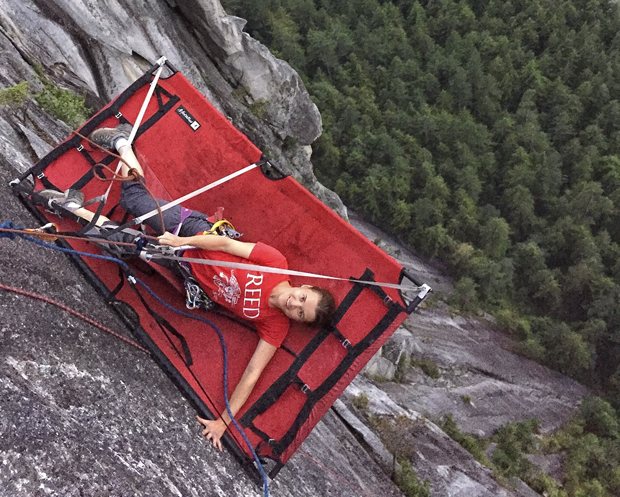After winning Wellington Prize, Professor Anita Hannig scales rock face in Canada
Hannig, an anthropology professor, went on the climb of her life after winning the $3,000 award.
 Photo/Anita Hannig
Photo/Anita HannigAnita Hannig sits on a portaledge on The Chief.
On most days, Brandeis professor Anita Hannig teaches about and researches the anthropology of death and dying.
But this summer, the tables turned and she stared death straight in the face.
Hannig won the Wellington Prize, a $3,000 award given each year by lottery to a junior faculty member that can only be used in pursuit of a non-academic venture. So Hannig, being a rock-climbing enthusiast, decided to use the money to scale and sleep on the side of a cliff in Canada’s Pacific Ranges.
“I’ve known for years what I would do with the money,” said Hannig, who — like all previous winners of the Wellington Prize — wasn’t present when her name was drawn. “I wanted to spend one night sleeping on the face of a cliff. When I told my colleagues they were like, ‘you couldn’t pay us to do that.’”
Hannig has been rock climbing off and on since high school and, coincidentally, made plans this summer to conduct research on medical aid-in-dying in Portland, Oregon. To make use of the Wellington Prize money, she set her sights on the Chief, a granite dome with a 2,303-foot peak in British Columbia.
The Chief, which is located in Squamish, is viewed as a Mecca of sorts for rock climbers. The climbing there is no promenade; it’s for serious climbers. Hannig had to learn new climbing techniques and how to pitch a portaledge, a platform which hangs off the side of a cliff when there’s no flat or safe place for a climber to sleep.
“I had never used a portaledge before,” Hannig said. “The terrain was actually safe to sleep on, but my challenge was to sleep on the side of a cliff.”
The grueling climb up the Chief involved strenuous multi-pitch climbing with sheer drops beneath. By the time she and her guide arrived at the spot where they would camp at 9 o’clock at night, exhaustion had set in. After cooking a quick dinner, it was time to test out the portaledge.
“It was absolutely terrifying,” Hannig recalled. “You get into this thing, and you’re still attached to a rope but everything feels extremely flimsy, and every time you move the portaledge is moving with you. Mentally, I couldn’t visualize closing my eyes even for a second.”
“I was strapped in but I was still clutching the rope, not trusting it,” Hannig added. “Intellectually, I knew I was probably safe but my body was not accepting it.”
As an expert in medical anthropology and the anthropology of death and dying, Hannig knew it was ironic that her desire to hang off a cliff was being confronted with her own fear of dying.
“I thought about that a lot,” Hannig said. “I was literally staring death in the face. I wasn’t ready. I thought, ‘if this thing for whatever reason falls, I’m just not ready.’”
Hannig wound up only spending ten minutes on the portaledge — for the rest of the night she slept in her sleeping bag on the bare but solid ground of a protruding rock — but she enjoyed the experience and sense of achievement.
“There were really stunning and beautiful views,” Hannig said. “And I felt pretty accomplished when I came down from the climb.”
“It’s okay to change course,” she added. “To honestly check in with yourself – is this something you really want to do? And to be open to new experiences, even super scary experiences, to be reminded of what it feels like when you’re trying to learn a new skill is very humbling. Learning new things feels vulnerable, and this experience was a reminder of that.”





